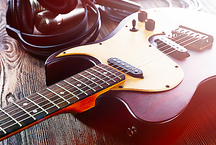12 best synthesizers

For many people, the passion for music begins with the purchase of a guitar - beaver acoustics or Chinese logs of the “Gibson type”. For many, but not for everyone: someone just likes electronic music, someone wants to have room for experimentation, but someone just sent to study the piano class at a local music school.
Today, having stretched our fingers and remembering chords more difficult than the fifth, we will try to understand what the electronic keyboard market offers us and choose the best popular synthesizers. What specifically pay attention to?
- Synthesizers for beginners - affordable, with built-in acoustics for homework and that does not interfere with the keyboard player-novice, with the function of learning. It will not replace classes with a teacher, but at least it will help develop a sense of rhythm and remember where there is a note among this cluster of white and black keys. It can be implemented in different ways - with prompts on the display, and dynamic highlighting of the keys themselves, which is much more convenient.
- Synthesizers middle price segment - we will not threaten the equipment for the pros, and even more so give them advice about the choice, but it’s worth considering tools that can be used for rehearsals and a small concert.
- MIDI keyboard although they are not synthesizers as such, it is for a home game that they will be an excellent option: sending commands to a computer will revive any virtual instrument (up to the craziest) that you install - and all this pleasure will be much cheaper, plus the possibility of “live »Games and recordings directly under accompaniment parts in sequencer editors. In addition, the sound quality of VST instruments will often be much better than in the built-in sound banks of cheap synthesizers.
Ranking of the best synthesizers 2018 - 2019
| Category | A place | Name | Rating | Price |
|---|---|---|---|---|
| The best synthesizers for training | 1 | YAMAHA PSR-E463 | 9.9 / 10 | 26 990 |
| 2 | Casio LK-280 | 9.8 / 10 | 20 990 | |
| 3 | Casio CTK-4400 | 9.7 / 10 | 16 990 | |
| 4 | CASIO LK-136 | 9.4 / 10 | 11 190 | |
| 5 | Medeli M311 | 9.0 / 10 | 9 100 | |
| 6 | Tesler KB-6190 | 8.9 / 10 | 7 515 | |
| The best synthesizers for an amateur musician | 1 | Casio WK-6600 | 9.7 / 10 | 30 990 |
| 2 | KORG microKORG | 9.6 / 10 | 32 000 | |
| Top Analog Synths | 1 | Moog sub phatty | 9.7 / 10 | 69 430 |
| 2 | KORG MS-20 Mini | 9.5 / 10 | 47 000 | |
| 3 | Novation Bass Station II | 9.4 / 10 | 39 000 | |
| Top MIDI Keyboards | 1 | Novation Launchkey 61 | 9.8 / 10 | 23 200 |
| 2 | Roland A-49 | 9.6 / 10 | 12 140 |
The best synthesizers for training
|
YAMAHA PSR-E463
26 990
Yamaha is positioning this model as a synthesizer for beginners, but this does not mean cutting back on the functionality - on the contrary, features have been added that an experienced musician would hardly need. For example, the Quick Sampling function is provided here - by connecting a smartphone or player via the AUX-in input, you can remove samples directly from it. For a novice musician who has not yet mastered working with sound on a computer, such an opportunity to quickly “make sound like in this track” will be useful for sure. Although the PSR-E463 has enough regular capabilities: 758 timbres, 235 types of accompaniment, 12 types of reverberation, et cetera, et cetera. With the use of Groove Creator, you can temporarily retrain from keyboard player to DJ: tune the rhythm, beat size and proceed to the mix. USB port allows you to record your game using a PC or smartphone, can also save WAV to a USB flash drive. Of course, the audio is digitized at 44.1 kHz / 16 bit, which immediately gives an amateur tool - but is it necessary to learn more? The synthesizer's dimensions are too big, but not just - it has enough controls. A 61 unweighted key with four touch speed settings is standard for this class. Built-in acoustics - two 6-watt speakers, and pleasantly sounding for this price. But the “training” here was thoroughly cut even compared to the “younger” Yamaha models and even more so with Casio, where exactly the training programs can be safely considered as being best implemented. Is it good or bad? Let's say this - although, of course, it will be harder to master the synthesizer from scratch, but it can take longer to “grow” out of it.Therefore, perhaps, we will give appreciation to the developers with additional points from the rating of the best synthesizers: the model turned out to be interesting and gives quite good opportunities to develop, and not to run on Avito immediately after receiving the basic skills of the game. Main advantages:
Minuses:
|
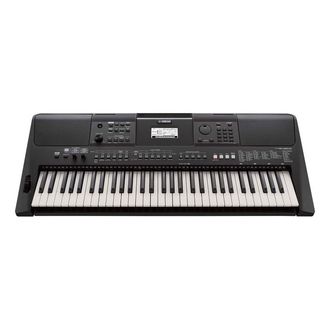 9.9 / 10
Rating
Reviews
Frankly, “for dummies”, the model decided not to take it - it’s better, in my opinion, to immediately take the item more decently, let it be without a lot of prompts and reminders. |
|
20 990
Even a child can learn from scratch on this synthesizer: in the learning mode, in addition to the prompts on the display, the backlighting of the keys themselves works, allowing not only to quickly find the right one, but also to orient by the pressing force. Remembering how in his time he tried to work out the algorithm “squiggle in notes, string and mod-devil, got off the rhythm” while learning the guitar, the author of these lines began to envy novice keyboard players.
A more experienced musician is likely to stick to the keys - yes, they are unweighted and are deprived of any feedback on the pressing force, but for an inexperienced musician this will not be an obstacle, rather, on the contrary, it will help to work out the technique without struggling with finger fatigue. Pianists will not like the built-in samples of their favorite instrument - indeed, they stand out unprofitably against the rest of the overly artificial, and even rattling with a strong blow (a fun implementation of a “live” game) sound. What is most interesting - the piano sounds pretty decent! What really liked it was the ability to connect to USB as an “almost” MIDI keyboard: after recording a lost part in the memory of the synthesizer, you can use it already in working with high-quality VST, writing complex compositions in sequencers. At least, lovers of all kinds of electronic genres, deprived of their “warm-light” keyboard, will definitely not interfere with loading their favorite PoiZone into FL Studio. Well, add for completeness the slot for SD-cards, on which you can store MIDI-files of accompaniment, microphone jack in case you want to sing along to your own game. Yes, the synthesizer came out not ideal in terms of sounding or sensations from the game, but just as an educational tool, it really worked out. And, in the end, it was in that capacity that we considered him. Main advantages:
Minuses:
|
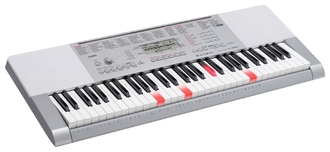 9.8 / 10
Rating
Reviews
Once in my childhood my parents tried to teach me to play the piano. They did not work, Casio - suddenly, yes! The best synthesizer for beginners! |
|
16 990
The design of this synthesizer is a classic for this price segment: 61 unweighted keys (but, we note, they are quite pleasant for fingers), built-in acoustics in the form of two 2.5-watt speakers. However, comparing it with competitors, you can give him a place at the very top of the palm.
Fans of experiments will appreciate the size of the standard library - and this is not less than 600 tones of various tools, complemented by high-quality effects. Of these, we especially note Virtual Hall - it was never so easy to feel yourself in front of a grand piano on the stage of La Scala with closed eyes (this phrase can be suggested by Casio for a commercial, hehe). It is easy to fill up the library of sounds with your own samples through the aux-input in just three steps: select the sampling mode, bank number (601 and higher) and start the signal from the player or computer. Of the additional "goodies" there is a USB connector for connecting to a PC (updating banks, editing MIDI accompaniments), a connector for the sustain pedal. The training mode due to the decent size of the display is quite convenient, besides there are almost 2 hundred variants of melodies in it - there is something to work out with the technique. In general, the Casio tool came out great for its price.Of the minuses here we note frankly boring acoustics - the sound she has is flat, forcing her to mentally sing along with "The plastic world of victory and…." It is necessary to connect the synthesizer to an external amplifier or to good headphones. Main advantages:
Minuses:
|
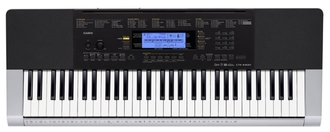 9.7 / 10
Rating
Reviews
Excellent "training desk", bought on the advice of the teacher. At rehearsals we connect to the amplifier - the sound is good, the mix is not lost. For a beginner - a very good synthesizer. |
|
CASIO LK-136
11 190
A typical inexpensive synthesizer for beginners - just a basic set of controls (for example, real-time controllers are definitely not enough), but with a large display and dynamic key illumination. Even a complete “teapot” will be able to deal with it, which can hardly distinguish the icons on the musical staff. The keys are very light, so this synthesizer will fit perfectly for children, but a more “heavy” instrument will suit an adult, especially if you have a sight on a “live” keyboard instrument. The game features are also only basic. Difficult compositions for the synthesizer are already impossible, few simultaneously processed keystrokes - but it’s okay, the “target audience” is not able to play with all ten fingers. But the lack of USB spoils the impression more: you can neither transfer audio to a computer, nor connect a synthesizer as a MIDI device. But instead, Casio offers a simple game of chords (in Casio Chord mode, pressing one key generates a full major chord, two for a minor chord), a convenient learning mode for any hand of your choice or two at once, good “dance music” modes. Built-in 120 timbres (without the possibility of adding your own samples), 100 compositions, 70 types of auto-accompaniment. Acoustics unpretentious - two dvuhvattnyh dynamics. In good headphones, the synthesizer sounds more interesting, but, of course, in terms of sound quality, it is still weaker than more advanced models for beginners. Main advantages:
Minuses:
|
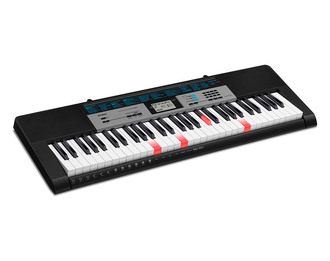 9.4 / 10
Rating
Reviews
They bought a synthesizer for his son, he figured out with him quickly. The acoustics are not powerful, so the neighbors do not complain. |
|
Medeli M311
9 100
If you need exactly an inexpensive instrument without high requirements for sound, then there is an option to save money by not turning to well-known brands. The Chinese synthesizer will offer 320 built-in timbres, and not the worst tutorial, and the ability to connect to a PC via a USB connector — the synthesizer can also work as a MIDI keyboard. What will have to pay for it? To begin with - frankly weak acoustics, and we are talking not only about the speakers, but about the sound path as a whole. The cutoff of the upper octaves is felt, a resonance is noticeable at the bottom of the MF range. The keyboard is a traditional 61-keyed, unweighted, touch sensitive, but overly light, not giving adequate feedback. On the other hand, think about the price. Medelli makes it possible to start inexpensively mastering both the keyboard instrument and the work with DAW on a computer - and high-quality VST, in combination with a decent sound card, will allow you to get a sound much better than the “built-in” one. Hence, the time of "growth" can be stretched. Main advantages:
Minuses:
|
 9.0 / 10
Rating
Reviews
It’s normal for training - I don’t think that the basic models of the same Casio will be much better, but they are also more expensive, moreover, without USB. |
|
7 515
If the first places in the ranking of the best educational tools were expectedly taken by synthesizers of brands that do not need to be presented, then this tool attracts attention primarily at the price - and for someone this parameter will become critical.Information about the manufacturer on the Internet is expected a little, and under this brand one can meet both refrigerators and sewing machines. So we have the next Chinese Elenberg or something like that - but, on the other hand, the price of the synthesizer is such that it is more accessible and there is no place.
The functionality here is expectedly limited - there are no connectors for the pedals (but there is USB), and there are only 200 built-in timbres. In the best Chinese traditions, the manufacturer tries to attract attention with “component” acoustics - tweeters and even bass reflex holes (!) Are seen near both speakers. Honestly, it’s hard to say that the sound is spoiling more - the acoustics or the synthesizer itself, but after the “Yamaha” it really doesn’t impress, a good amplifier and acoustics somewhat correct the situation. The training mode is usual for inexpensive synthesizers, based on built-in tunes with prompts on the display. It is quite well read, so that the “learning” here is suitable for use, and not added for a tick. Keyboard ... Well, let's say, traditional unweighted. After more expensive instruments, it is frankly unpleasant with its plasticity, but here it is worth remembering again about the price of the synthesizer. He fully justifies it - the same Yamaha is almost twice as expensive. Main advantages:
Minuses:
|
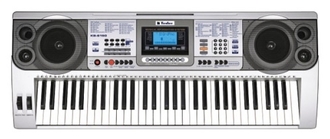 8.9 / 10
Rating
Reviews
I bought it, played it and, having learned to tolerate my fingers well and realizing what I specifically wanted, went to choose a permanent synthesizer. In the end, for that cheap tools and invented. |
The best synthesizers for an amateur musician
|
30 990
The increased width of the synthesizer made it possible to place not only all 76 keys on it, but also very good component acoustics: the home game will not strain your hearing with the flatness or plasticity of the sound, and you will need an amplifier during rehearsal or concert. The tool offers the user a built-in library of 700 tones and 100 effects, plus the same number of effects he can load himself. The sound can also be colored “manually” with the Pitch Bend wheel, which allows you to vary the sound in the range of 12 semitones. Plus, we plug the microphone into the appropriate connector, and you can safely go to “work out the tavern” with songs about Magadan ... stop, it was already somewhere.
The ability to quickly recall rhythmic patterns and their fast search by the encoder will also be useful during performances in a “truncated” composition, and for a musician playing in a group they will be useful during home rehearsals. The keyboard can be virtually “divided” for two different instruments with the possibility of mixing their sound in a common output. Of the minuses, we note that for the sake of price, the quality of the keyboard had to be sacrificed: the “delicious” sound and the easy-to-configure instrument are not as pleasant to the touch as one would expect from first impressions. On the other hand ... Still, remember the price and the fact that you can safely act with this budget. Main advantages:
Minuses:
|
9.7 / 10
Rating
Reviews
The best, in my opinion, and affordable synthesizer. A rich selection of sounds, you can play and sing to the accompaniment of a good machine and not risk being booed. |
|
32 000
The musician doesn’t always need a keyboard in more than 6 octaves - for example, the techno lover to carry a seven kilo Casio with him will definitely not like it. So let's look in the direction of the 37-key "microcorg". Even the names of the modes under the round selector - techno, trance and so on - immediately hint at the main purpose of the synthesizer.
It is enough to play a little on it to begin to pursue a sense of déjà vu.Indeed, Korg sound banks in electronic music are like Marshall JCM800 for guitarists: they can be heard from a huge number of bands. Because of its small size, the “kid” is deprived of built-in acoustics, but it can boast of having two MIDI ports (input and output) and analogue sound controllers that are so cute electronics lovers - pitch and modulation under the left hand, right-on top are the usual cutoff, resonance controls and so Further. The “bonus” to the list of functions is the built-in vocoder. It is very easy to edit the “stuffing” of the synthesizer - just connect it to a PC with the microKORG Sound Editor installed. In general, if you know what oscillators are, and why mix the saw with a sine wave, this synthesizer will be the best choice. We will not advise the newcomer exactly: from one setting with two selectors and five "twists" on the table in the style of "devil's leg breaks" he will have a shock. Main advantages:
Minuses:
|
 9.6 / 10
Rating
Reviews
When you get tired of playing, you can just turn the sound and find all new and new features in the small “Korg”. |
Top Analog Synths
|
Moog sub phatty
69 430
A classic subtractive analog synthesizer in a nostalgic aluminum case (in our plastic time) will definitely please the sound. It is capable of producing at least a new-fashioned and boring electronic field, even a “tube” sound - the main thing is to set up the distortion processor correctly. Moreover, the obvious functions of the regulators are not all the features of Sub Phatty, part of the “hidden functions”, which you can not even guess, caused by a combination of buttons. So for the first time, stock up with a lectern and put the instruction manual on it. The sound of Moog is the very thing you expect from this company. Fleshy, dense, responsive to manipulations with regulators. And the character of the sound is absolutely recognizable - you will not confuse it with Novation or Arturia. The Multidrive circuit used here is an excellent combination of an OTA filter and a FET-drive, the sound with it changes over a wide range, and the sensitivity to adjusting oscillators is not coarse over the entire range. A third one is added to the two main oscillators, delivering a square wave an octave below oscillator No. 1 for a more “fleshy” sound, as well as a noise generator. There are CV / Gate inputs. To recap: are you looking for a powerful and flexibly customizable “with character” sound? The answer has been traditional for many years: Moog. Main advantages:
Minuses:
|
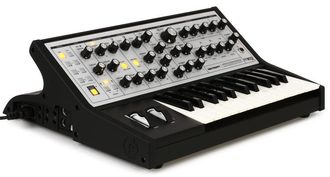 9.7 / 10
Rating
Reviews
Something really uncommon - easily gives a sound that can cut through any environment, not to get lost in the composition. |
|
47 000
At the sight of this keyboard hybrid with an old telephone PBX, someone would weigh the jaw in shock, and personally the author of these lines played a record in the memory of the old Latvian Zodiac group. Presets? Sound banks? But take a bite! The sound of this instrument is created literally by hand - with analog “twisters” in the amount of 36 (!) Pieces and by switching a set of generators and filters with cords (add as many sockets to the “twisters”). A person accustomed to the “remnants” of modern digital synthesizers will freeze and go into reboot at the stage of mastering the synthesizer. But a fan of electronic music “exposure” for more than 25 years will have a foolish smile in the process of tuning, and the effort to creep up to the ears. Yes, this is really an analog synthesizer, not its digital imitation, and you can’t confuse the character of its sound - its scheme is based on the legendary Korg MS-20 already in 1978.The fact that it was supplemented with a digital signal processor that allows you to connect a synthesizer to a PC (and even, God forbid, an iPad) and play MIDI from an external source, looks close to blasphemy. Alas, this tool is still specific, many fans of modern electronics will scare away the very idea of adjusting the sound by switching plugs on the panel according to the block diagram. So for a glaring (and excellent) non-universality, we still lower his rating score. Main advantages:
Minuses:
|
 9.5 / 10
Rating
Reviews
If you have never switched effects chains into a gap and parallel, but only switched presets on a computer - pass by, MS-20 mini is not for those! |
|
Novation Bass Station II
39 000
The synthesizer (as well as other analog) "on the fan", but what! At one time, it was with a compact “analogue”, as opposed to overall devices with switching by a bundle of wires, few of whom then a well-known English company surprised the world. Of course, in the two thousandth, the company focused mainly on controllers and audio interfaces - but the more interesting is its “return to roots”, marked by Best Value Award from Audiofanzine, Editor’s Choice Award from Electronic Musician, third place in the Music Radar ranking and many other awards. Just two octaves on the keyboard? But 24 regulators, 11 selectors and 13 buttons are at your disposal. Same “analog” - here the sound is created as in the alchemist’s laboratory. And, of course, there is an “iron” MIDI input and output, supplemented by MIDI implementation via USB (and with a USB connection, you can also take power from the computer). There are a lot of possibilities for the synthesizer, although the impression is spoiled by the implementation of regulators (control is not the most convenient compared to other models of this type). Bass Station II can produce both aggressive sound for modern music styles, and the nostalgic sound of the eighties. Just twist the knobs - unless, of course, you understand all these LFOs, DCOs and their ilk. And all this is relatively inexpensive. So, if you have already played enough with the emulation of analog synthesizers in various VST and decided to "touch" it with your hands, Bass Station II can be a good choice. Main advantages:
Minuses:
|
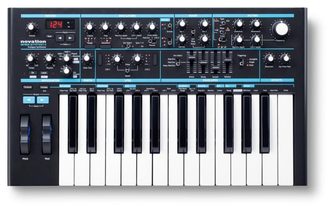 9.4 / 10
Rating
Reviews
Analog synth is still a catchy thing. In theory, you can simply hang the samples on the usual ... But it's still not that! |
Top MIDI Keyboards
|
23 200
61 full-size key with excellent pressure sensitivity plus 16 pads, also with pressure and velocity sensors - this in itself perfectly characterizes the instrument. Application for professional use and bundled software - the whole package is designed to work under MacOS, de facto recognized as the standard for professional work with music. It is enough to “hang up” on the pads the activation of clips and tracks in the sequencer (by the way, their backlighting is flexibly configured, serving as a kind of reminder of the purpose of a particular pad), and on the computer's MIDI input - the desired VST instrument, and you can fully appreciate the functionality of this keyboard . Immediately at hand - convenient analog controls. In short, the purchase of this keyboard can be considered successful both for home use and for a small studio. It costs its money. Main advantages:
Minuses:
|
 9.8 / 10
Rating
Reviews
An indispensable studio assistant: why buy a lot of tools when there are excellent VST plug-ins and Launchkey? |
|
Roland A-49
12 140
Excellent 49-key keyboard with the ability to connect the pedals. Keys with decent feedback and “after touch” are tactilely pleasant and do not make noise on their own. And the D-BEAM controller at all allows you to feel like a player on a thereminx - it uses an infrared sensor that reacts to hand movements above itself. Another control is traditional for Roland - it is a joystick that simultaneously allows you to change the modulation and pitch. This makes it possible to create the craziest sounds for which the traditional separate controls will be overly uncomfortable. An important plus of the keyboard is its mobility: it is light and not very large, without suffering from a lack of durability. It’s a pity that for the sake of compactness, she lost the pads - on the MIDI-keyboard, they, no matter how cool, are very useful. Main advantages:
Minuses:
|
 9.6 / 10
Rating
Reviews
I really liked the keyboard - it takes up a limited amount of space at home with maximum efficiency, the “feel” is very pleasant. |
So, what to look for when choosing the best synthesizer?
First of all, naturally, on keys - the more you need the sounds of "live" instruments, the greater the requirements for them. “Empty” unweighted keys will feel like playing text on a computer keyboard, heavy weighted ones will create a full sense of a “live” piano and allow you to work out the right technique for playing it. Half-weighted will be a compromise - tools with them and do not shock at the price, and are really pleasant in the game.
Attention deserve and other characteristics of the keys. Playing an instrument that does not have sensitivity to force and speed of pressing will very quickly seem fresh and boring - in the absence of a sound dependence on articulation, the playing technique will suffer. If the tool also has sensitivity to aftertouch, then it can already be safely recommended for purchase.
Opportunity loading your own samples and rhythms for a synthesizer, more must have than an optional feature: adjusting the sound to yourself or replacing a frankly unsuccessful factory one will never hurt, especially on inexpensive synthesizers. Otherwise, the bass players will laugh at you, reader, remember this!


